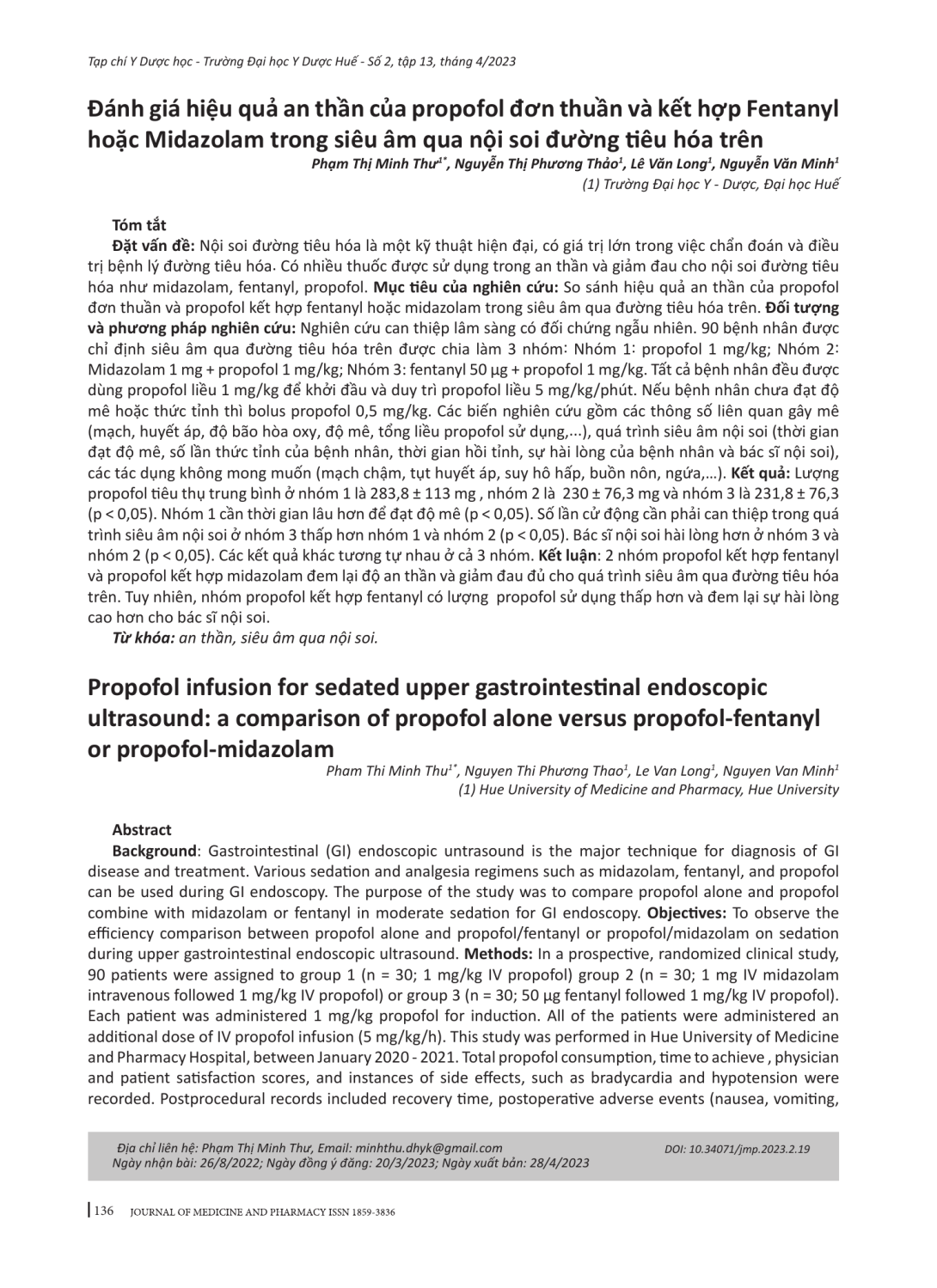
So sánh hiệu quả an thần của propofol đơn thuần và propofol kết hợp fentanyl hoặc midazolam trong siêu âm qua đường tiêu hóa trên. Đối tượng và phương pháp nghiên cứu: Nghiên cứu can thiệp lâm sàng có đối chứng ngẫu nhiên. 90 bệnh nhân được chỉ định siêu âm qua đường tiêu hóa trên được chia làm 3 nhóm: Nhóm 1: propofol 1 mg/kg; Nhóm 2: Midazolam 1 mg + propofol 1 mg/kg; Nhóm 3: fentanyl 50 μg + propofol 1 mg/kg. Tất cả bệnh nhân đều được dùng propofol liều 1 mg/kg để khởi đầu và duy trì propofol liều 5 mg/kg/phút. Nếu bệnh nhân chưa đạt độ mê hoặc thức tỉnh thì bolus propofol 0,5 mg/kg. Các biến nghiên cứu gồm các thông số liên quan gây mê (mạch, huyết áp, độ bão hòa oxy, độ mê, tổng liều propofol sử dụng,...), quá trình siêu âm nội soi (thời gian đạt độ mê, số lần thức tỉnh của bệnh nhân, thời gian hồi tỉnh, sự hài lòng của bệnh nhân và bác sĩ nội soi), các tác dụng không mong muốn (mạch chậm, tụt huyết áp, suy hô hấp, buồn nôn, ngứa,…). Kết quả: Lượng propofol tiêu thụ trung bình ở nhóm 1 là 283,8 ± 113 mg , nhóm 2 là 230 ± 76,3 mg và nhóm 3 là 231,8 ± 76,3 (p < 0,05). Nhóm 1 cần thời gian lâu hơn để đạt độ mê (p < 0,05). Số lần cử động cần phải can thiệp trong quá trình siêu âm nội soi ở nhóm 3 thấp hơn nhóm 1 và nhóm 2 (p < 0,05). Bác sĩ nội soi hài lòng hơn ở nhóm 3 và nhóm 2 (p < 0,05). Các kết quả khác tương tự nhau ở cả 3 nhóm. Kết luận: 2 nhóm propofol kết hợp fentanyl và propofol kết hợp midazolam đem lại độ an thần và giảm đau đủ cho quá trình siêu âm qua đường tiêu hóa trên. Tuy nhiên, nhóm propofol kết hợp fentanyl có lượng propofol sử dụng thấp hơn và đem lại sự hài lòng cao hơn cho bác sĩ nội soi.
Gastrointestinal (GI) endoscopic untrasound is the major technique for diagnosis of GI disease and treatment. Various sedation and analgesia regimens such as midazolam, fentanyl, and propofol can be used during GI endoscopy. The purpose of the study was to compare propofol alone and propofol combine with midazolam or fentanyl in moderate sedation for GI endoscopy. Objectives: To observe the efficiency comparison between propofol alone and propofol/fentanyl or propofol/midazolam on sedation during upper gastrointestinal endoscopic ultrasound. Methods: In a prospective, randomized clinical study, 90 patients were assigned to group 1 (n = 30; 1 mg/kg IV propofol) group 2 (n = 30; 1 mg IV midazolam intravenous followed 1 mg/kg IV propofol) or group 3 (n = 30; 50 μg fentanyl followed 1 mg/kg IV propofol). Each patient was administered 1 mg/kg propofol for induction. All of the patients were administered an additional dose of IV propofol infusion (5 mg/kg/h). This study was performed in Hue University of Medicine and Pharmacy Hospital, between January 2020 - 2021. Total propofol consumption, time to achieve , physician and patient satisfaction scores, and instances of side effects, such as bradycardia and hypotension were recorded. Postprocedural records included recovery time, postoperative adverse events (nausea, vomiting, dizziness, recall, and pain) and satisfaction. Results: The average propofol consumption was 283.8 ± 113 mg in Group 1 and 230 ± 76.3 mg in Group 2 and 231.8 ± 76.3 mg in Group 3 (p < 0.05). The incidence of moving ( motor or verbal) was lower in Group 3 (p < 0.05). The physician satisfaction was higher significantly in Group 3 (p < 0.05). Total propofol consumption was higher in group 1 significantly. Time to onset of sedation was significantly higher in group 1 The physician satisfaction was higher significantly in Group 3. Overall, the other results were similar in 3 groups. Conclusion: Both propofol/fentanyl and propofol/midazolam combinations provided appropriate hypnosis and analgesia during upper gastrointestinal endoscopy. However, propofol consumption was significantly lower and greater endoscopist satisfaction in group using the propofol/ fentanyl combination.
- Đăng nhập để gửi ý kiến
